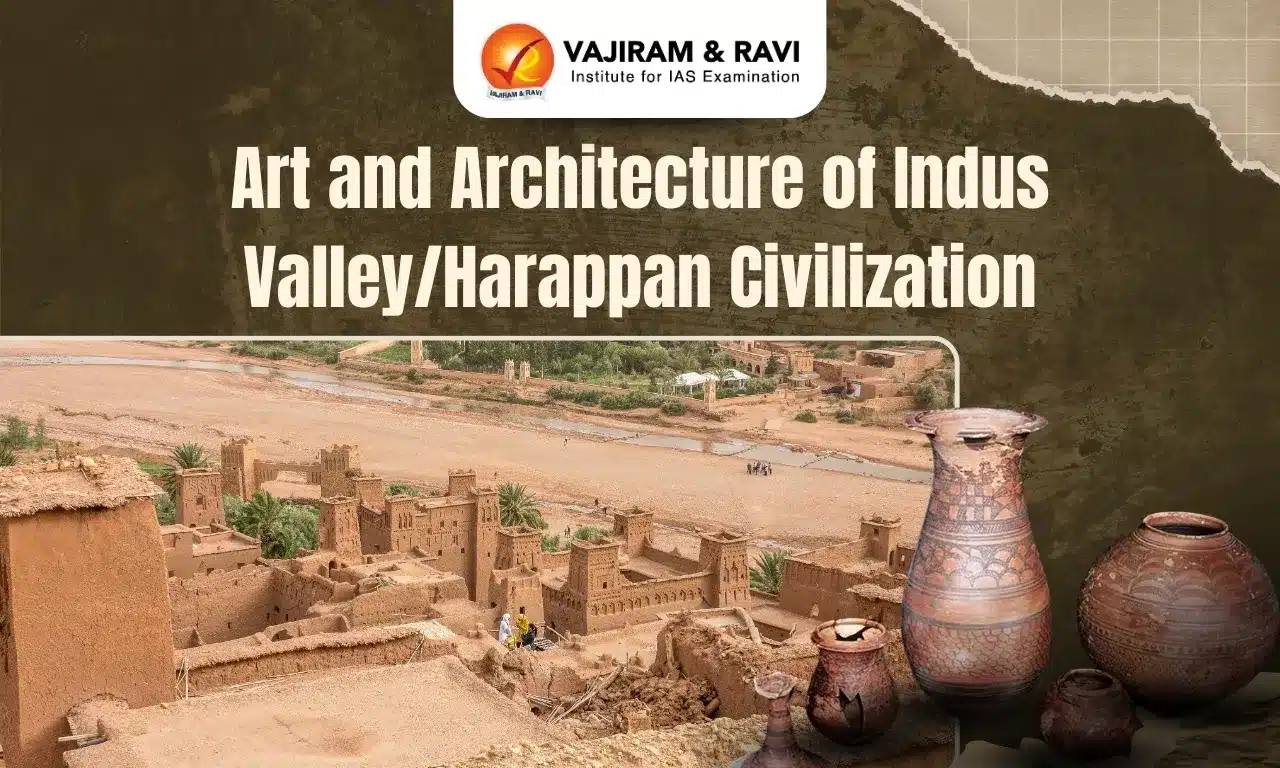The Indus Valley/Harappan civilisation was the first urban civilisation in South Asia, coexisting with Mesopotamia and Egypt. The Harappan civilisation occupied the largest area (approximately 8,00,000 sq km) among the three civilisations. It made noteworthy contributions to the art and architecture of the ancient history of India.
Nature of the Art and Architecture of the Indus Valley Civilisation
- Arts: Artists of the Indus Valley civilisation era had fine artistic sensibilities and a vivid imagination evident from the anatomical details included in the unique arts, their delineation of human and animal figures was highly realistic in nature, and in the case of terracotta art, the modeling of animal figures was done with extreme care.
- Architecture: The architecture of the Indus Valley Civilization was very unique. The architecture during this time was used for the purpose of functions and not for beauty or decoration. The evolution of the architecture of civilization occurs in isolation. It has been influenced by the local cultures, which prevailed previously years back of the first farming and pastoralist settlements.
Architecture of Harappan Civilization
The Harappan culture was distinguished by its system of town planning on the lines of the grid system – that is, streets and lanes cutting across one another almost at right angles, thus dividing the city into several rectangular blocks.
- The Pattern of Houses: Many of the cities of the Indus Valley civilization were divided into two or more parts: the citadel and the lower town.
- It is believed that the citadel was a fortified settlement and comprised of some chief structures, such as the great bath and the warehouse, while the lower town consisted of houses and workshops.
- Only 6 citadels have been found, showing that only priests or higher classes used to live there.
- The pattern of streets and roads: Indus Valley streets and roads were straight and cutting each other at a right angle. The roads were built using burnt bricks.
- Drainage system: The drainage system of Indus Valley civilization connected all houses to the street drains, which were covered by stone slabs or bricks. Houses with single, double, and more rooms attached with a very good drainage system were found in many of the sites of the Indus Valley.
- Burial sites: At burials in Harappan sites, the dead were generally laid in pits. Some graves contain pottery and ornaments, indicating a belief that these could be used in the afterlife. Jewellery has been found in burials of both men and women. In the excavations at the cemetery in Harappa in the mid-1980s, an ornament consisting of three shell rings, a jasper (a kind of semi-precious stone) bead and hundreds of microbeads was found near the skull of a male.
| Architecture | Feature |
|
Great Bath at Mohenjo Daro |
|
|
Great Granary |
|
|
Dockyard at Lothal |
|
Arts and Artifacts of the Indus Valley Civilization
During the second half of the third millennium BCE, the arts of the Indus Valley Civilisation emerged. Sculptures, seals, pottery, gold jewellery, terracotta figures, and other forms of art have been discovered at various sites throughout the civilisation.
| Arts | |
| Sculpture | Feature |
| Stone statues |
|
| Bronze Casting |
|
| Terracotta figures |
|
| Seals |
|
| Pottery |
|
| Ornaments used by the Harrapans |
|
| Literature | |
| Script |
|
What is the Significance of Harappan Art and Architecture?
- Foundation for civilisations: One of the earliest notable urban civilisations is the Harappan civilisation. It set out the routines, perspectives, responses, and standards that served as the foundation for the following eras in Indian history.
- Brotherhood: The artefacts from the Harappan civilisation reveal that there was remarkably little intergroup violence despite centuries of immigration, climatic changes, and social, political, and economic upheavals. As a result, this culture valued brotherhood, and excess wealth did not lead to economic divisions.
- Urban architecture: In many ways, this culture serves as an exceptional model for the modern world. The Harappans were unmatched experts in drainage systems, water harvesting and management systems, and town planning. This laid the foundations for present-day urban planning.
- Sanitation: The perfection of the drainage system and the private bathrooms in every home show how important cleanliness and hygiene were to the Harappans. As a result, the Harappan civilisation laid the groundwork for both individual and societal hygiene in urban planning.
- Secular: From the discovery at any of the Harappan sites, it is clear that religious discrimination was largely absent and that social ties and notions of the fraternity were stronger.
- External relations: The first urban civilisation in India to establish trade relations with other countries was the Harappan civilisation. It thus paved the way for emerging civilisations to strengthen their ties with the outside world. In a sense, this serves as the foundation for modern globalisation.
Last updated on November, 2025
→ Check out the latest UPSC Syllabus 2026 here.
→ Join Vajiram & Ravi’s Interview Guidance Programme for expert help to crack your final UPSC stage.
→ UPSC Mains Result 2025 is now out.
→ UPSC Notification 2026 is scheduled to be released on January 14, 2026.
→ UPSC Calendar 2026 is released on 15th May, 2025.
→ The UPSC Vacancy 2025 were released 1129, out of which 979 were for UPSC CSE and remaining 150 are for UPSC IFoS.
→ UPSC Prelims 2026 will be conducted on 24th May, 2026 & UPSC Mains 2026 will be conducted on 21st August 2026.
→ The UPSC Selection Process is of 3 stages-Prelims, Mains and Interview.
→ UPSC Result 2024 is released with latest UPSC Marksheet 2024. Check Now!
→ UPSC Prelims Result 2025 is out now for the CSE held on 25 May 2025.
→ UPSC Toppers List 2024 is released now. Shakti Dubey is UPSC AIR 1 2024 Topper.
→ UPSC Prelims Question Paper 2025 and Unofficial Prelims Answer Key 2025 are available now.
→ UPSC Mains Question Paper 2025 is out for Essay, GS 1, 2, 3 & GS 4.
→ UPSC Mains Indian Language Question Paper 2025 is now out.
→ UPSC Mains Optional Question Paper 2025 is now out.
→ Also check Best IAS Coaching in Delhi
Art and Architecture of Harappan Civilization FAQs
Q1. At which Harappan site was the dancing girl sculpture discovered?+
Q2. Which language was the Harappan script written in?+
Tags: art and architecture of indus valley civilization quest




















